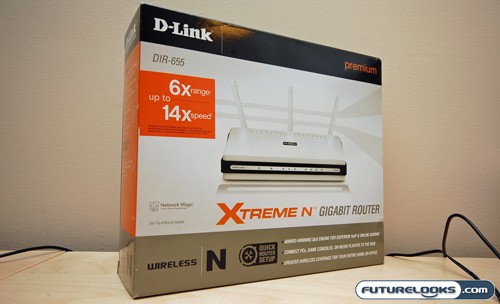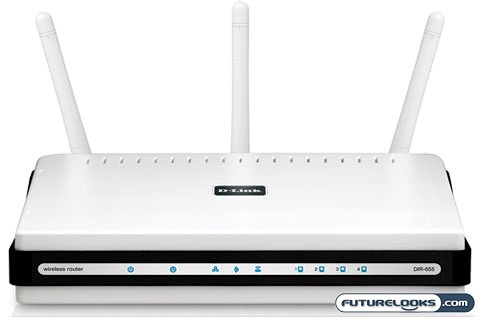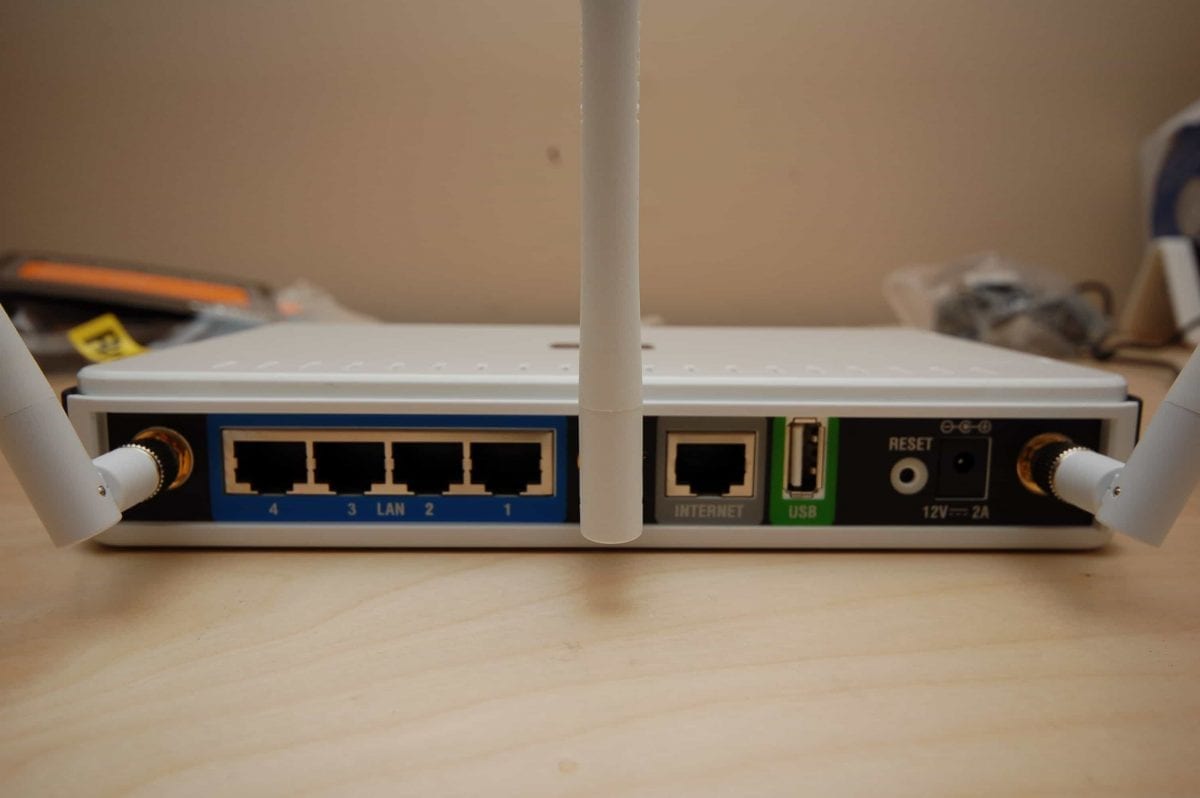
The network router has become as common as the microwave in most households. Especially with such affordable ethernet prices today. These magic boxes have all but become a commodity at our local computer stores, but the quest for more speed and more importantly, wireless connectivity, has led to more congestion on today’s networks. Throwing bandwidth at the problem is merely a temporary fix as eventually, we run out of it all over again. That’s why UBICOM and D-Link have gotten together to create a product that addresses congestion on both the wired and the wireless through the power of something called a “StreamEngine” processor.
D-Link’s DIR-655 Xtreme N Gigabit Router gives us plenty of bandwidth with a built in four port Gigabit switch on the wired side and Draft N wireless capability up to 300 Mbps. They say this is 14x faster than 802.11 G, but by my math, it should only be 5.5x faster (300 / 54…anyways). It also boasts improved range, up to 6X more range, than regular D-Link 802.11g routers. Getting this range requires the use of one of their Xtreme N wireless adapters, so no Xtreme N on both ends, no Xtreme N range.
The DIR-655 Xtreme N router also features the following:
- Secure your wireless network using advanced WEP™, WPA™, or WPA2™ encryption.
- Easy to get started with D-Link’s new Quick Router Setup Wizard
- Supports Good Neighbor Policy — will not interfere with other wireless networks.
- Backward compatible with 802.11g and 802.11b devices including game consoles and digital media players.
There’s one more feature that we need to talk about in a bit more depth and that’s the, you guessed it, UBICOM StreamEngine Technology.
It’s Smarter Than a Fifth Grader…
Although the DIR-655 sports a rather attractive white Apple iPod like finish and burly triple antennas, it’s more than just a pretty router.

The DIR-655 belong’s to D-Link’s Xtreme N series of wireless routers which feature the UBICOM StreamEngine processor. This “Extra Brain” if you will, acts like a traffic cop to prioritize and direct time sensitive data. Why is this important? It’s important because let’s just say that you’re in a VOIP call, when all of a sudden, the voice on the other side starts sounding broken up and then drops every few seconds. Annoying huh? That means that the time sensitive data isn’t getting there on time and this extra latency is killing your conversation.
The processor takes the traffic generated by these types of requests and puts it above your requests for loading up a web page or downloading stuff on your favourite peer to peer network; stuff that doesn’t require high priority. Other things that require high priority and low latency include online games where lagging can really kill your frag count. It’s also useful for streaming video over a wireless network. Now this isn’t the first time that we’ve looked at this technology. It first appeared when we reviewed the Hawking Technologies HBB1 Broadband Booster which was no more than a little box that we thought was some snake oil trinket. But when we noticed improvement in our VOIP phone calls with vs without it, we knew something was up.
Later when we reviewed the D-Link DI-724 Wireless 108g QoS Router, it used an upgraded version of the processor built into the router, but what we discovered was as we added more wireless devices like the Nintendo Wii, Xbox 360, and several laptops, performance started to drop off. The problem was that although the StreamEngine processor was prioritizing wired traffic, it wasn’t doing the same for wireless traffic. The processor inside the DIR-655 prioritizes traffic for both wired and wireless and with 300 Mbps to mess around with, it should be a dream team.
What’s In The Box?
For a router this nice looking, it’s pretty much standard fare inside the box. Of course you get the router, but you also get a set of screws for mounting it to a wall, an upright stand, power adapter, a CAT 5e cable, setup CD and a piece of paper telling you to put the CD in the computer and run it before plugging in the router.
Checking Out The Hardware
Just in case you haven’t gotten the picture yet, they want you to run the CD First, but before we do that, let’s get a quick look at the router. Of course, the router features a triple antenna design that extends the range and coverage of the unit, but they are also removeable, allowing you to replace them with any number of aftermarket antennas that can boost its range even further.
The back of the router also features four Gigabit Ethernet ports and a port labelled specifically for plugging in your…Internet…like your cable or ADSL modem. But of course, you won’t do that till you “Run the CD First”. Also on the back of the router is a USB port for plugging in things like USB flash drives or hard drive enclosures…so you would think. The port is used for Windows Connect Now which nobody uses. It doesn’t even allow you to plug in a printer and use the router as a print server. So basically it’s a useless USB port. To the far right is the master reset button and the power connector.
The DIR-655 can be placed either horizontally or vertically using the included stand. The router even comes with mounting screws to allow you to mount it to the wall if you’re so inclined to.
D-Link also provided a set of their Xtreme N Laptop network cards so that we can take full advantage of the extended range and full 300 Mbps of speed. The come in PCMCIA and Express Card versions for both old and newer systems. D-Link also makes a PCI Express and PCI versions of their desktop cards, but we’ll be concentrating on the laptop versions because that’s where the action is.
Setting Things Up
Finally, we get to “Run the CD First”! Actually, I didn’t run the CD first. I just plugged the router in and it started working right away, however, if you’ve never setup a router before, I do recommend running the CD because it is a very detailed and intuitive setup. The CD will also give you an option to install Network Magic, which is a great utitlity that allows you to add and configure your network through a very easy to use and powerful user interface.
Even if you don’t “Run the CD First”, setup is very easy regardless. People lose CD’s and it seems that D-Link understands that. Directly connecting to your router via a network cable, you are able to access the router’s settings menu. The initial setup screen gives you options to use an intuitive setup wizard, or do a manual setup. I found the setup wizard to be well laid out and it stepped you through everything including wireless security settings, which most people forget about due to the number of wide open networks that I often run across.
Although there are a number of settings you can use to fine tune the StreamEngine settings, I would subscribe to the “If it ain’t broke, don’t mess with it” philosophy. I found the automatic settings more than adequate for my testing, but if you so choose, you can do quite a bit of tweaking to the point of pre-prioritizing specific devices on your network for even better performance. Fortunately, I felt no need to screw around with these settings at all at any point in my evaluation of this device.
After configuring the router, we installed the DWA-643 Xtreme N Express Card into an ASUS U1F ultra portable laptop. Once we plugged in our network and security settings, we were immediately connected to the DIR-655 Xtreme N router and basked in the glory of 300 Mbps over the air. Next, we’ll do a few comparisons with the 802.11n against the old stanby 802.11g which include real world transfer speeds, range, and the performance and effectiveness of the StreamEngine processor over wireless.
Xtreme N in Action
Well, Draft N Version 2.0 to be exact. We thought it’d be fun to do a real world head to head test of how much faster Xtreme N is over regular 802.11g. We transfered a 1 GB folder of files from our network attached storage server connected via Gigabit Ethernet to our ASUS U1F laptop via the built in 802.11g and again with the DWA-643 Xtreme N Expresss Card. Here are our real world results:
- 1 GB File Transfer – 802.11g – 6:45
- 1 GB File Transfer – 802.11n – 2:11
The DIR-655 definitely isn’t 14X faster than regular 802.11g. Not even close. In fact, it isn’t even 5.5X faster as I calculated (how many times does 54 go into 300?). However, it is about three times faster in our real world file transfer.
How About that 6X Range?
Well, I guess people like to exaggerate or in this case or make it hard for you to find out where the numbers come from…
In the real world, we’ve discovered that wireless signal strength was stronger, but how does this translate to 6X more range? In the same spot, about one floor down from the DIR-655 router, the 802.11g card registered 3 out of 5 bars of signal, while the Xtreme N adapter maintained full signal strength. So, yes, it is stronger. So where does the 6X come from?
Taking a walk out and about, I was probably about a block away before the signal totally dropped out on the Xtreme N card while the built in 802.11g signal was long gone. However, even as I walked away from the office, and out the door, and down the street, with 300 Mbps to mess around with, I was still getting a good amount of bandwidth, for most of the walk. In essence, I was getting 5.5X more bandwidth to start with, and then when I was down to around one bar to failure on the 802.11g card, I was around 5 Mbps or less there, but I was still around 80 – 100 Mbps on the Xtreme N card, which is…roughly 14X faster. So in theory, I was also getting around 6X more range. I love where the marketing people fetch their numbers from, but I wish they’d use the real numbers so that anyone could open the box, plug it in, and get what is advertised right away instead of having to hunt.
Looks like D-Link really wants you to buy their network card though, but for the boost in speed and signal tenacity it certainly is worth it.
StreamEngine Technology Goes Wireless
As I’ve mentioned before, I’ve tried out the StreamEngine technology built into other products, and both products did well…on a wired network. It was time to switch on all the laptops, game systems, and other wireless devices to see if we could maintain a VOIP call like I could with just a pure wired network. Now keep in mind, I’ve tried this all before with the D-Link DI-724 which is StreamEngine enabled on the wired side, and it wasn’t cutting it once wireless traffic went through the roof.
I switched on the Wii, the Xbox 360, three laptops, and proceeded to start transfers on a couple wired systems to my network attached storage server. I even jumped on Xbox Live and started a conversation while sending a Fax with my other Vonage line. Now, keep in mind, my calls on the D-Link DI-724 could not be placed without severe drop out. Basically, I could not even have a conversation.
With the DIR-655 on the network, except for a few clicks and pops during the call, I was able to place and maintain a call that was clear enough to be acceptable. That’s something I couldn’t do before and that’s definitely a huge improvement. Just for fun, I even streamed some videos while on the call, and they played without any problems the majority of the time. I can safely say that the StreamEngine wireless technology is doing its job and doing a lot to help prioritize traffic to ensure that the stuff that is time sensitive gets to the front of the line.
Finally Thoughts
The DIR-655 Xtreme N router is a necessary evolution. No one likes to drill holes in their house to fish CAT 5 cable and running a wireless router is a perfect solution. However, as network loads increase, the bandwidth provided by this router should provide lots of headroom for future expansion. But the 300 Mbps of wireless bandwidth love is just half the story.
Networks are also becoming increasingly depended on for use with VOIP, gaming, and streaming video and audio; things that are extremely latency sensitive. The UBICOM StreamEngine processor inside the DIR-655 is no joke. Whenever you can actually feel a difference in the way your network runs, that’s a big deal. Even with the heavy loads I threw at the router both wired and wireless, I was still able to maintain acceptable performance of time sensitive requests.
Although I’m all praise so far, I have to take exception to the claims of 6X more range and 14X faster speeds. It’s neither under practical use. Yeah, I know it is claimed as “Up To” but to have to “hunt around” to verify these claims in testing is a little sketchy. The range of the router is definitely impressive, and because of the extra bandwidth, you can work with a fairly decent connection in places you couldn’t before. The other gripe I had was the fact that the USB port could not be used for printers, something that seems necessary in today’s multi-computer households. Actually, to be more accurate, the USB port is all show, and no go. You can’t even plug a USB drive into it and share it on the network. However, I’m sure the fans of Windows Connect Now will be happy. Are there any?
It’s been a few months now since I was given the D-Link DIR-655 Xtreme N Gigabit router to torture. Since I’ve had commodity network routers fail on me personally in fairly short time periods, I was not about to recommend a router at this price point without a good amount of thrashing for at least a couple months. After beating on it and pushing horrible traffic loads through it, 24/7, for a few months now, I can safely say that this is one product that will not fail on you and provide excellent performance without worry.
Despite the slightly deceptive marketing, the D-Link DIR-655 Xtreme N Gigabit Router is a proven workhorse that will serve you well as the hub of your Wired and Wireless Network. It provides tangible benefits over its commodity counterparts, and although it isn’t cheap, it isn’t a place you want to cheap out as you start adding your VOIP phones, wireless media players, and gaming systems. The DIR-655 Xtreme N Router is absolutely necessary for powering your Digital Lifestyle and I really couldn’t imagine my network without it. Editor’s Choice!
Pros
- Fast 300 Mbps performance with Xtreme N adapters
- Full backwards compatibility with other wireless standards
- StreamEngine Technology really works to maintain network performance for time sensitive requests
- Proven reliability for 24/7 operation
Cons
- Costs more than your standard commodity router (but it’s worth it!)
- Marketing claims of 6X and 14X are slightly deceptive
- The USB port is completely useless
Overall Rating: 9.0 / 10.0
Discuss This Review in the Futurelooks Community Forums

